Day 10
May 13, 2003
(Tuesday)
Istanbul, Turkey
7:00 am
We wake up cruising into the fabulously exotic port of Istanbul, and hoo boy,
is that some view we get! The landscape is littered with mosques and you can see
the graceful minarets all over the city.
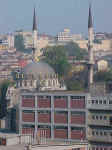
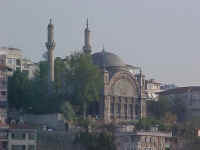
Some of the mosques we can see on the way into Istanbul
In honor of this ancient and exotic beauty, Robert cranks up "Istanbul (Not Constantinople)"
on the laptop and tries to get the ship to sing along.
Istanbul not Constantinople,
Now it's Istanbul not Constantinople,
Why is it Istanbul and not Constantinople?
That's nobody's business but the Turks!
This lasts about 30 seconds (the amount of time it takes Laura to locate a large
blunt object and begin advancing on Robert).
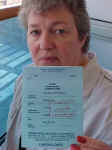
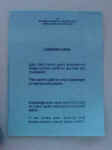
Laura holds up the Landing Card we have to fill out and carry with us everyplace
8:53 am
We're in the bus again, headed for a half day tour of Istanbul ("Not Constantinople!"
cries Robert). Our feet inform us that they're not up for a full day of chasing
up and down hills, so we opt out of the full day tour.
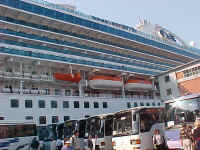
Once again, our boat dwarfs a pier full of tour buses
Although the ride into Istanbul is pretty astonishing, the port itself is extraordinarily
mundane. About all you can see is a zillion tenements and one mosque.
The deal with mosques is that each mosque should be built barely within earshot
of another mosque so that everyone hear the call to prayer. The end result is
that there's a mess of them. In the last 10 or 20 years, they've been using amplified
calls to prayer (which also saves the poor Imam from having to climb up 80 zillion
stairs to the top of the minaret). Lately, though, they've been going back to
the old ways (Imam climbs stairs, and then sings the call to prayer). Maybe the
Imams were getting a bit chubby...
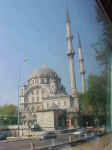
Turkish mosque
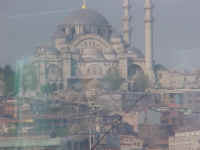
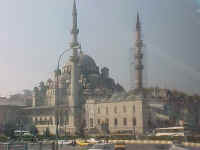
A big mosque, the two tower things are the "minarets"--the imam gets to climb
to the top and holler out the call to prayer
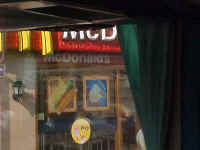
Yup, there's one of these in Istanbul
Praying five times a day is one of the five pillars of Islam (the five things
that are the absolutely most important things for a Moslem to do).
What are all five? Funny you should ask:
-
Pray five times a day
-
Make the pilgrimage (hajj) to Mecca at least once
-
Give 10% of your income to the poor
-
Observe the month of Ramadan by fasting & praying
-
Acknowledge that there is no God but Allah and Mohammed is his prophet
So, the prayer thing is pretty important to devout Moslems. The five times for
prayer are:
-
sunrise
-
when the sun is directly overhead
-
when the sun is at a 45 degree angle
-
sunset
-
late at night.
The Imam announces prayer time and that point, the Moslems wash up, lay out a
prayer mat (or head to a local mosque, or just find a nice, clean space) and start
praying. The prayers last about 10 to 15 minutes.
Our guide is Nilgun (but it sounds like "Nellie," so that's what we call her).
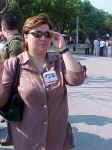
Nilgun, our guide to Istanbul
Nilgun says that you can hardly tell when it's prayer time (remember, Turkey is
officially secular). She estimates that maybe 20% of the population are devout
Moslems.
The population of Istanbul ("Not Constantinople!") is about fourteen million people,
although they're not altogether sure. Seems that the Turks are none too fond of
being counted and are always moving about, so it gets hard to keep track of them.
Half of the city is in Europe and the other half is in Asia. There's a bridge
that connects the two continents ("When the bridge opened in 1973, Danny Kaye
came and danced on it"). We'll be spending our day on the European side of the
city.
Nilgun gives us the local definition of "new": anything less than 600 years old.
(So, Washington State is like a little tiny baby...)
Istanbul started as a small Greek village. Later, the Romans came through and
liked it, so they conquered it. In fact, at one time, they even moved their headquarters
here. Then the Byzantines took over, and after a number of centuries, the Ottomans
moved in. Finally the Turks got control of their own country.
Part of the attraction (aside from being right between two continents, and pretty
much on the Invasion Throughway), is that there's a harbor called the "Golden
Horn" that runs about five miles and is sheltered (it's a long spit of land).
That means you can park a whole mess of boats here, and back in the old days,
when everybody drove boats instead of cars, that was mighty convenient.
Nilgun tells us that there are about a million cars in Istanbul ("Not Constanti--ow!"),
but only 75,000 parking spaces (thereby making New York City look like a giant
Diamond Parking Lot). The result of this is that the Turks park pretty much anywhere,
sometimes two and three cars deep and on the sidewalks.
9:20 am
We are now headed to the Blue Mosque. The rules for going into a mosque are: no
shorts, no shoes. You can take as many pictures as you want, and they don't much
care if you wear a hat or not.
The Blue Mosque has six minarets, and the legend is the Sultan asked for "golden"
minarets, and apparently "golden" sounds a lot like "six" in Turkish, so the architect
whipped up six minarets. (Robert ponders how that would work in English: the architect
heard "sex minarets" and built tall, phallic looking--hey, wait a minute!)
This caused a religious scandal, because no mosque can have more minarets that
the mosque in Mecca. At the time the Blue Mosque was built, the mosque in Mecca
only had four minarets. This problem was solved by adding three minarets to the
mosque in Mecca (thus achieving minaret parity). A couple of more minarets got
added over the years to the Mecca mosque, so now it's got nine minarets.
Imperial mosques (ones built by a Sultan or ruler) always have more than one minaret.
Regular plain old mosques (such as ones built today) only have one minaret (which
is really all you need).
The Blue Mosque (six minarets) is right next to the "Hippodrome," which in the
second century AD was the center of the city. Contrary to what Robert thinks,
the Hippodrome was not where they brought hippos to fight, but where chariot races
were held.
To kind of jazz the place up (and also to show off their power) the Romans brought
in an old (even then) Egyptian obelisk. This obelisk, carved from a single piece
of granite) is currently about 3600 years old, so even 1800 years ago, it was
an antique.
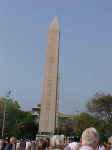
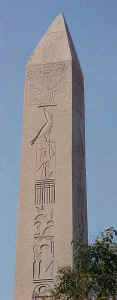
Antique Egyptian obelisk
Our heads are beginning to hurt from trying to comprehend all this old stuff...
We're surrounded by various vendors trying to sell us stuff (everything, curiously
seems to be "One dollah, one dollah," except for the stuff that is "cheaper than
cheap!").
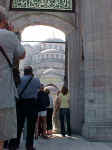
Tourists line up to take a picture of the mosque through the doorway
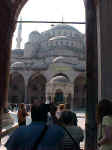
We're almost at the front of the line!
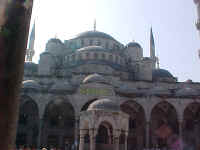
The view you've been waiting for!
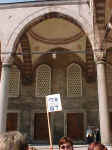
One of the archways near the entrance (today we're in tour group B7)
We walk into the Blue Mosque (barefoot), and hoo boy! is it spectacular! Giant
arched domes covered in intricate designs soar over our heads. The entire floor
is carpeted (machine spun, not hand spun). It really, really feels like something
out of Arabian nights, only way cooler.
The Blue Mosque is so-called because inside it's mostly blue (duh...). Some of
the blue is blue paint, and some is blue glass tile. It was built in 1609 and
only took seven years to finish (which is lightning fast for a religious building
in this part of the world).
Inside, the pillars holding it up are 5.5 meters in diameter (eighteen feet, or
0.003 nautical miles). Up to 2,500 people can pray at a time inside the mosque
(they can open up an outside courtyard if they want to accommodate more people
who pray).
Glimpse into the Geek Writing Life of Robert & Laura
We have a 10-minute discussion on what you would call somebody who prays. A
"prayer" is confusing. A "supplicant" or "intercessor" would be engaging in a
specific type of prayer. We finally decide to use "person who prays." Fun,
isn't it?
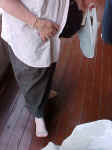
Laura takes her shoes off in preparation to enter the Blue Mosque (handy plastic
bags for storing shoes provided as a service by the mosque)
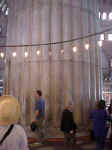
Laura looks up at one (!) of the pillars holding up the roof
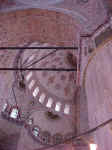
The roof being held up by the pillar
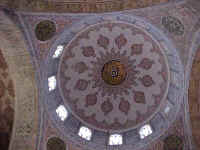
The center of the roof
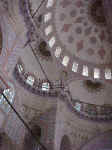
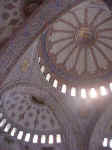
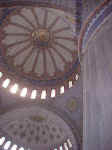
More roof shots
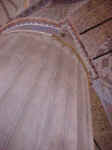
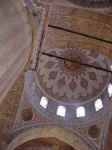
More of the pillar
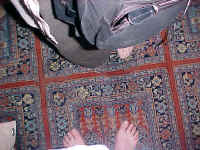
Robert's feet on the mosque carpets
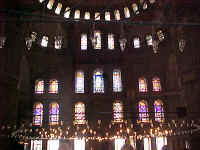
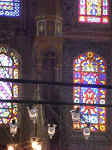
And there's some lovely stained glass windows
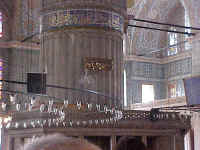
Side view of the pillar
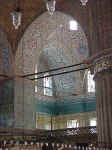
Some of the intricate tile work
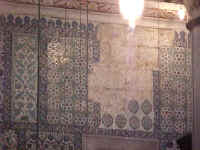
Somebody stole some of these tiles, so now they have better security
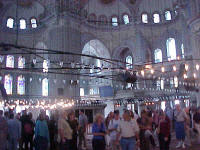
The Blue Mosque is popular with tourists
10:00 am
We leave the mosque and put our shoes back on and head towards St. Sophia's, which
is just across the Hippodrome.
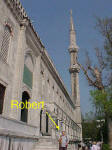
Robert outside the Blue Mosque
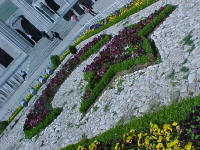
Nearby, the flowers are arranged to resemble the Turkish flag
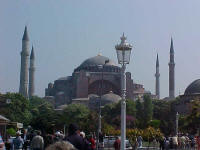
Nope, that's a lamp post, not a minaret
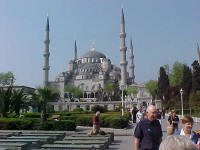
The "postcard view" of the Blue Mosque
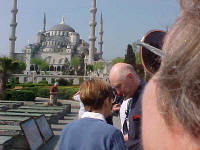
Laura gazes at the Blue Mosque
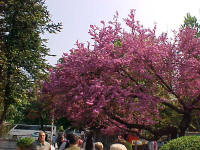
You can always tell the pictures that Laura takes: this is some tree or
another that she thought looked nice outside the Blue Mosque ("It's not even
blue!" says Robert)
Robert spies some guys with big tanks on their backs selling stuff ("Might be
espresso!") so he buys a cup of it for $1. He drinks about half of it before thinking
to ask Nilgun what it is (cherry juice).
St. Sophia was built three times as a Christian church. The first two times, it
was built from wood, and it burned down. The third time, the Roman Emperor Justinian
said, "Let's make this baby fireproof and snap it up!"
So it was built from stone in the early 500's and took a mere five years to complete
(gotta admire that Roman efficiency!).
Of course, when Istanbul came under the sway of Moslems, they couldn't keep it
as a church, so they converted it to a mosque. The church was full of mosaic pictures
of Jesus, Mary, and the rest of the Holy Gang. Only problem is that Moslems don't
believe in making images of people (it's too much like making people, which only
Allah can do).
Rather than rip them all out, though, they just plastered them over. When Ataturk
(remember him? Mr. Modern Day Turkey?) came along, he said, "This is way too cool
to lose, let's uncover the mosaics and turn it into a museum." So they did.
So now it's a mish-mosh of church and mosque, with a little museum tossed in.
Fortunately, back then, churches were built facing east, and mosques also face
east, so they didn't have to knock out any walls during the conversion. They added
the Moslem preaching pulpit and made a few other modifications, but you can easily
see where the church was.
Oh yeah—if you were thinking that being a Sultan was a nice gig...The Sultan
had a partitioned off area where he could pray in private. Not because he was
too haughty to pray with the peons, but because it was safer, on account of there was
a long list of people interested in shortening his life. (And then there's the
whole harem thing where you might have 30 sons all eager to commit half-brothercide
to move up the succession chain.)
The church is currently being restored, and you can see what a huge difference
it makes. The colors are brighter and you get a much better idea of how cool it
was in its day.
A Cool Thing
If you watch "From Russia With Love" (a James Bond movie) there's a whole
scene that takes place in St. Sofia (bad guy stalks James, badder guy kills
bad guy). We recognized it, and we can vouch that it really is St. Sofia, and
not a Hollywood set.
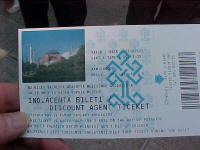
The ticket shows a lovely view of St. Sofia
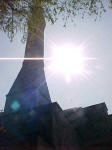
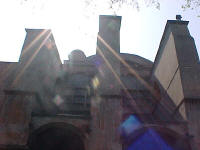
Robert gets all artsy taking pictures of St. Sofia
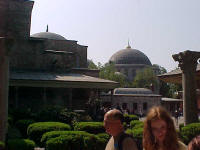
Here, you can see the domes of St. Sofia and some people we don't know
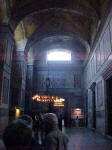
The Narthex to St. Sofia, rather more elaborate than most churches
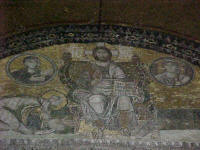
One of the mosaics that had been covered up
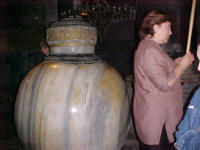
Nalgen stands next to a giant jug used to hold Holy Water
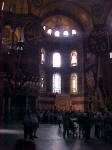
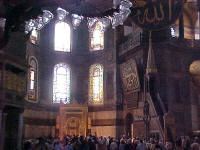
The inside of the church/mosque, you can see giant round medallions with
Arabic writing on them
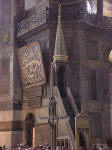
This is where the imam walks partway up and then preaches to the
congregation
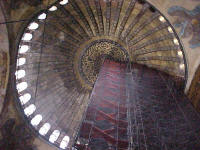
The ceiling center, with scaffolding all the way up, you can see where it's
been cleaned (from noon to about 3:30)
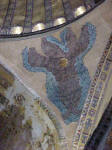
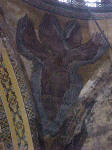
After and before shots of the difference the cleaning makes (it's a picture
of an angel with six wings, described in the Bible)
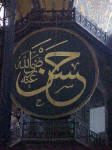
Close up of one of the Arabic medallions
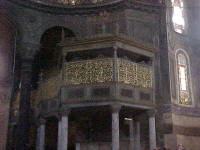
The Sultan's box, where he could worship without fear of being stabbed,
poisoned, or strangled
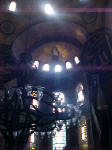
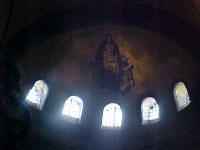
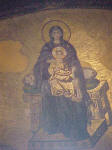
A mosaic of Mary & Toddler Jesus
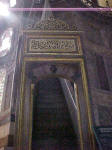
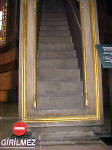
Turns out the little tower thing is called a "Mimbar"--the plaque says:
"A mimbar in a mosque corresponds in function to the pulpit in a church. This
is a fine example of Ottoman-period marble-working craftsmanship 16th
century."
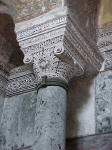
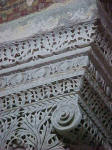
The tops of these pillars are hand-carved from a single block of stone
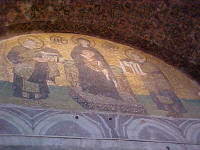
Another mosaic about which the plaque says:
The Virgin between Justinian and Constantine.
To the left: Constantine presenting a model of his new city Constantinople
To the right: Justinianus presenting a model of his new church Hagia Sophia
10th Century
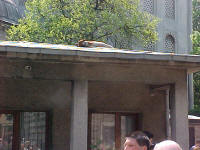
We thought this dog sleeping on top of the roof was interesting--how the
heck did he get there?
11:04 am
We're back on the bus, headed for the Grand Bazaar. One thing we notice is that
there's a cop about every 10 feet everywhere in Istanbul. Although they have littler
guns than the Italians (the Italians carry 9 mm Glock automatics, while the Turks
have cute little .30 caliber Berettas), there's a whole bunch more of them (cops,
not guns, although since there's more cops, it follows that there's more guns,
but there's still only one gun per cop, if you follow).
We certainly feel secure (especially when we spot the undercover cops--"How do
you know they're cops?" asks Robert, "Civilians don't usually carry walkie-talkies,"
says Laura).
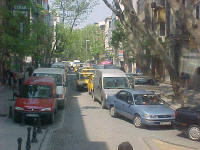
Typical Istanbul street scene, a direct result of 1,000,000 cars and only
75,000 parking spaces
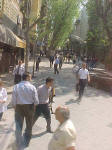
Of course, there's plenty of people on foot, too
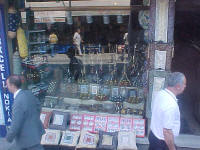
For the finest in hookahs, visit Abdul Hookah Emporium!
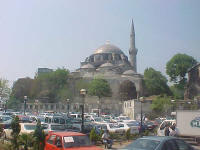
St. Sofia in the distance
There are 4,200 shops in the Grand Bazaar and as we step in, we can believe it!
It stretches forward as far as the eye can see. Each shop is about ten feet across,
and comes complete with a Turk outside trying desperately to attract our attention.
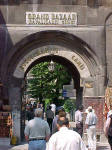
The entrance to the Grand Bazaar
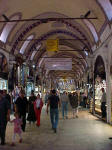
Inside the Grand Bazaar
Walking down the Grand Bazaar is just like being in a movie (except everybody
is hollering in English, and not Turkish). "See my jewelry!" "Good bags! Leather!
Cheap!"
We stop at a jewelry store where Laura sees a bracelet that she likes (it's just
like the one that the vacuum cleaner ate twenty years ago). Robert likes the bargaining
part and just wishes he knew more Turkish (phrases like "You are ripping my heart
out and stomping on it!" and "For that price, I could buy your entire shop!" would
be handy).
On the way out, the shop owner introduces his uncle who has a leather shop, but
we take a pass on it (since it's 80 degrees outside, a leather jacket does not
strike us as particularly comfortable). We pick up a few more things (Turkish
music, purses, miniature carpets) doing our best to inject a few bucks into the
local economy.
We're also very careful to pay attention to our path. We can see side passages
that lead to side passages that lead to utter confusion and being lost in the
Grand Bazaar for hours. Which would be fun, until we reached the point where the
boat left without us...
We duck into an open square about 30 feet across. A large tree grows in the center
of the square, and there's a cafe, a belly dancer supply shop, and two carpet
shops. There's also an old hand-pumped water spigot that looks like parts of it
might date to Roman times. We order coffee and join the Turkish pastime of sitting
in the sun sipping strong coffee and chatting.
Nearby a handful of cats are sitting on a roof and mewing loudly. The carpet merchants,
sit in front of their shops, looking bored. A waiter carries food and tea from
the cafe out to the shops. Above, one of the carpet merchants adjusts the carpet
display on the second floor.
A giggle of school girls comes by and ducks into the belly dancing supply shop.
We can see them trying on the hip belts and chattering.
A man comes out from one of the shops and begins feeding the cats, tossing them
meat, and making sure that each cat gets some. It's clear that this is what the
cats were waiting for and they dig right in.
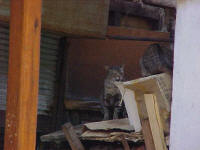
Cats on the roof
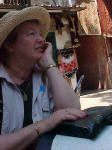
Laura wonders what the cats are up to
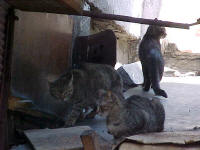
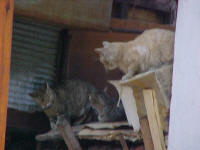
The cats wish the guy with the meat would hurry up
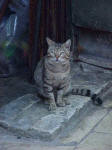
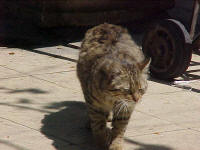
This cat was clearly the Top Cat--he sauntered about the square like he owned
it
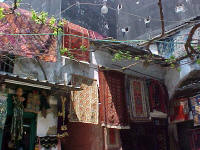
Carpets on display in the square
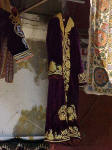
A robe hangs outside the belly dancing supply shop
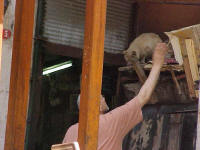
"It's about damn time, buddy," say the cats
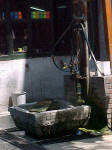
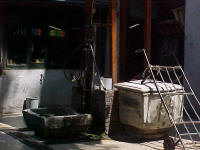
A water pump that's older than the U.S. and still works
Noon Hunger finally catches up with us, and Robert acquires a new Turkish word:
Kushbashili.
This means: Pizza! Kushbashili! Kushbashili! Kushbashili!
Laura opts for the buffet, where she can point at stuff that looks good (which
is pretty much everything).
Oddly enough, the restaurant sends out for the Kushbashili (the restaurant owner
shrugs and laughs, saying "It's Italian! We get from Italy!"). Eventually, a guy
comes running down the alleyway carrying a plate covered with butcher paper. He
takes it inside where it's transferred to another plate, and Robert has a Turkish
pizza! (Lamb, tomatoes, and jalapeno peppers.)
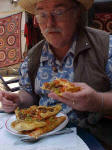
Kushbashili! Kushbashili! Kushbashili!
12:55 pm
We make it back to the bus, for the return trip to the ship. We careen down narrow
streets barely big enough for one car, but magically passing two lanes of traffic.
We also drive past a McDonald's and discover that Turkish for "Mail Boxes, Etc."
is "Mail Boxes, Etc."
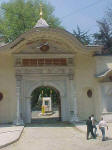
A cool looking entrance to something or the other
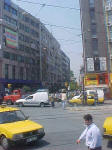
Istanbul looks pretty much like any modern city
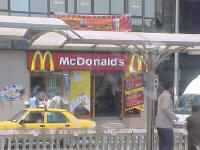
It even has one of these...
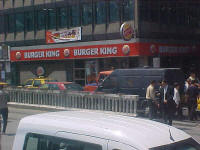
But at least in Istanbul there's some competition
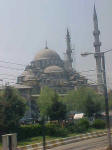
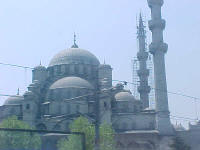
A mosque undergoing renovation
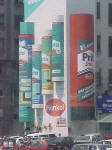
We have no idea what they're selling, but it looks kind of cool (pipes?
sodas? shaving cream?)
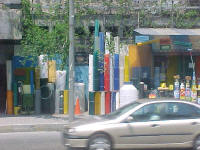
These guys are definitely selling, um, colored pipes?
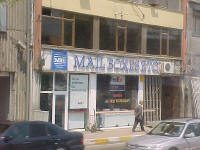
What "Mailboxes Etc." translates to in Turkish
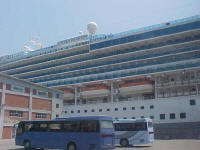
We return once again to our floating hotel room
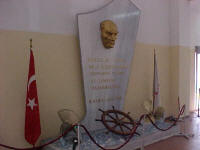
A memorial to Ataturk
We collapse in our stateroom and look out our window at Istanbul. Even Robert
is too tired to sing the song....
Pulling out of Istanbul, on our way to Venice
Robert & Laura
|
